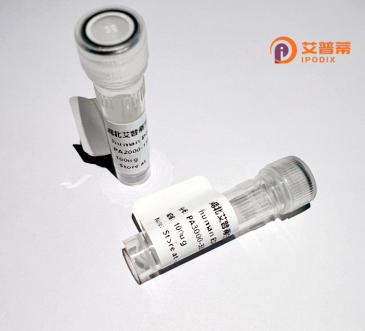
| 纯度 | >90%SDS-PAGE. |
| 种属 | Human |
| 靶点 | C13orf26 |
| Uniprot No | Q8N6G2 |
| 内毒素 | < 0.01EU/μg |
| 表达宿主 | E.coli |
| 表达区间 | 1-289aa |
| 氨基酸序列 | MEQPGPRAPDPSLCHHNLQPTDDPNWDSYATTMRTAFTPKTGAVPALIRQNGIRRLGYTYSLSDPILNQTQYSDEYTWKSHSKEDLIKTETSRGIKSHKSHLNEDIFLWTLPHCQQTGTLKNCLPWKIPASMKEVNKALSNQFISLTKRDFVDRSKAQKIKKSSHLSLEWKKLLPQPPDTEFRRNYQIPAKIPELQDFSFKYGCYSSLPVASQGLVPSVLHSYLRNQEHTKKQTTYQSDYDKTYPDFLMLLNSFTSSQVKEYLQSLSYKDRQIIDRFIRTHCDTNKKKK |
| 分子量 | 33.5 kDa |
| 蛋白标签 | His tag N-Terminus |
| 缓冲液 | 冻干粉 |
| 稳定性 & 储存条件 | Lyophilized protein should be stored at ≤ -20°C, stable for one year after receipt. Reconstituted protein solution can be stored at 2-8°C for 2-7 days. Aliquots of reconstituted samples are stable at ≤ -20°C for 3 months. |
| 复溶 | Always centrifuge tubes before opening.Do not mix by vortex or pipetting. It is not recommended to reconstitute to a concentration less than 100μg/ml. Dissolve the lyophilized protein in distilled water. Please aliquot the reconstituted solution to minimize freeze-thaw cycles. |
以下是关于重组人C13orf26蛋白的3篇代表性文献的简要概括(注:C13orf26的官方命名已更新为 **TNRC6B**,部分文献可能使用新名称):
1. **文献名称**:*"TNRC6B interacts with tristetraprolin to destabilize cytokine mRNA"*
**作者**:Huntzinger, E., et al.
**摘要**:研究揭示了TNRC6B(原C13orf26)作为microRNA介导的基因沉默复合体(RISC)的关键组分,通过结合mRNA降解因子tristetraprolin(TTP),调控炎症细胞因子mRNA的稳定性,影响免疫应答过程。
2. **文献名称**:*"Structural and functional analysis of the human TNRC6B gene"*
**作者**:Lazzaretti, D., et al.
**摘要**:通过重组TNRC6B蛋白的结构解析,发现其含有GW重复结构域,介导与Argonaute蛋白的相互作用,并证实其在microRNA通路中的核心作用,为基因沉默机制的分子基础提供了证据。
3. **文献名称**:*"TNRC6B regulates breast cancer cell invasion via miRNA-mediated pathways"*
**作者**:Liu, X., et al.
**摘要**:利用重组TNRC6B蛋白进行功能实验,发现其通过调控特定miRNA(如miR-221/222)的表达,影响乳腺癌细胞的迁移和侵袭能力,提示其作为肿瘤治疗靶点的潜力。
**备注**:C13orf26现属于TNRC6家族(TNRC6A/B/C),多数研究聚焦于其在RNA代谢及癌症中的作用。如需具体文献,建议通过PubMed等数据库以“TNRC6B”或“C13orf26”为关键词检索近年研究。
**Background of Recombinant Human C13orf26 Protein**
The C13orf26 protein, encoded by the *C13orf26* gene (also known as *FAM170A*) located on chromosome 13q14.11. is a poorly characterized protein with limited functional information in current scientific literature. It is classified as a member of the "family with sequence similarity 170" (FAM170), though its exact physiological role remains elusive. Studies suggest that C13orf26 may play a tissue-specific role, with mRNA expression detected in human tissues such as the testis and thyroid gland, hinting at potential involvement in reproductive or endocrine systems.
Recombinant C13orf26 protein is produced via genetic engineering, often expressed in *E. coli* or mammalian cell systems to enable functional and structural studies. The protein’s primary structure includes conserved domains indicative of possible post-translational modifications, though these features require experimental validation. Preliminary research has proposed links to cellular processes like differentiation or stress responses, but mechanistic insights are lacking.
Interest in C13orf26 has grown due to its upregulation in certain pathological conditions, including cancers, suggesting it may serve as a biomarker or therapeutic target. However, its regulatory networks, interactome, and precise biological functions remain undefined. Recombinant C13orf26 serves as a critical tool for advancing antibody development, *in vitro* assays, and elucidating its role in health and disease. Further studies are necessary to unravel its molecular significance and potential clinical relevance.
×